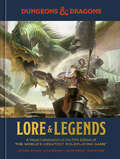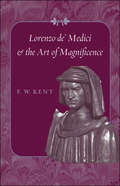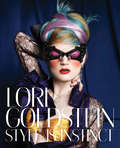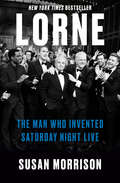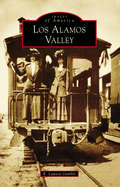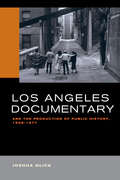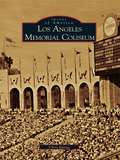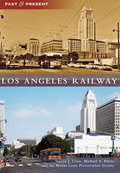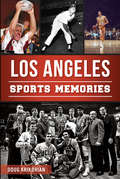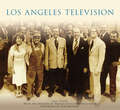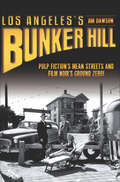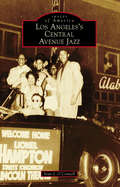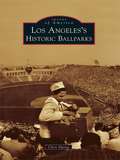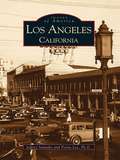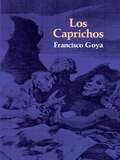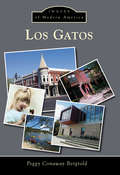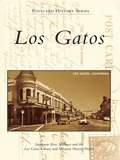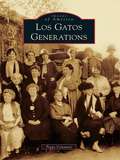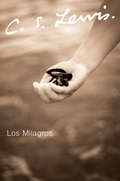- Table View
- List View
Lore & Legends: A Visual Celebration of the Fifth Edition of the World's Greatest Roleplaying Game (Dungeons & Dragons) (Dungeons & Dragons)
by Michael Witwer Kyle Newman Jon Peterson Sam Witwer Official Dungeons & Dragons LicensedAn illustrated guide to Dungeons & Dragons&’ beloved fifth edition told through interviews, artwork, and visual ephemera from the designers, storytellers, and artists who bring it to life. When the reimagined fifth edition of Dungeons & Dragons debuted in the summer of 2014, the game was on the brink of obsolescence. But within a few short years, D&D found greater success than it had ever enjoyed before, even surpassing its 1980s golden age. How did an analog game nearly a half century old become a star in a digital world? For the first time, Lore & Legends reveals the incredible ongoing story of Dungeons & Dragons fifth edition from the perspective of the designers, artists, and players who bring it to life. This comprehensive visual guide illuminates contemporary D&D—its development, evolution, cultural relevance, and popularity—through exclusive interviews and more than 900 pieces of artwork, photography, and advertising curated and analyzed by the authors of the bestselling and Hugo Award–nominated Dungeons & Dragons Art & Arcana.
Lorenzo Ghiberti’s Gates of Paradise
by Amy R. BlochThis book examines the heretofore unsuspected complexity of Lorenzo Ghiberti's sculpted representations of Old Testament narratives in his Gates of Paradise (1425–52), the second set of doors he made for the Florence Baptistery and a masterpiece of Italian Renaissance sculpture. One of the most intellectually engaged and well-read artists of his age, Ghiberti found inspiration in ancient and medieval texts, many of which he and his contacts in Florence's humanist community shared, read, and discussed. He was fascinated by the science of vision, by the functioning of nature, and, above all, by the origins and history of art. These unusually well-defined intellectual interests, reflected in his famous Commentaries, shaped his approach in the Gates. Through the selection, imaginative interpretation, and arrangement of biblical episodes, Ghiberti fashioned multi-textured narratives that explore the human condition and express his ideas on a range of social, political, artistic, and philosophical issues.
Lorenzo de' Medici and the Art of Magnificence (The Johns Hopkins Symposia in Comparative History #24)
by F. W. KentIn the past half century scholars have downplayed the significance of Lorenzo de' Medici (1449–1492), called "the Magnificent," as a patron of the arts. Less wealthy than his grandfather Cosimo, the argument goes, Lorenzo was far more interested in collecting ancient objects of art than in commissioning contemporary art or architecture. His earlier reputation as a patron was said to be largely a construct of humanist exaggeration and partisan deference.Although some recent studies have taken issue with this view, no synthesis of Lorenzo as art patron and art lover has yet emerged. In Lorenzo de' Medici and the Art of Magnificence historian F. W. Kent offers a new look at Lorenzo's relationship to the arts, aesthetics, collecting, and building—especially in the context of his role as the political boss (maestro della bottega) of republican Florence and a leading player in Renaissance Italian diplomacy. As a result of this approach, which pays careful attention to the events of his short but dramatic life, a radically new chronology of Lorenzo's activities as an art patron emerges, revealing them to have been more extensive and creative than previously thought. Kent's Lorenzo was broadly interested in the arts and supported efforts to beautify Florence and the many Medici lands and palaces. His expertise was well regarded by guildsmen and artists, who often turned to him for advice as well as for patronage. Lorenzo himself was educated in the arts by such men, and Kent explores his aesthetic education and taste, taking into account what is known of Lorenzo's patronage of music and manuscripts, and of his own creative work as a major Quattrocento poet. Richly illustrated with photographs of Medici landmarks by Ralph Lieberman, Lorenzo de' Medici and the Art of Magnificence offers a masterful portrait of Lorenzo as a man whose achievements might have rivaled his grandfather's had he not died so young.
Lori Goldstein
by Lori GoldsteinA stunning anthology of the work of visionary stylist Lori Goldstein, whose interpretations of fashion and beauty have produced some of the most groundbreaking and iconic images in fashion and popular culture. Lori Goldstein: Style Is Instinct publishes for the first time in book form the work of one of the worlds most highly regarded stylists. With a foreword by Steven Meisel, it features more than eighty astounding images that she created in collaboration with the worlds finest photographers--including Annie Leibovitz, Mario Testino, Bruce Weber, Meisel, and many others--for fashion editorials, renowned advertising campaigns, and award-winning music videos. This striking volume captures Goldsteins personal credo, which has come to define her work--"everything goes with anything"--and displays her signature style, from her unique way of mixing and matching print and color to how she uses clothes to create images that go beyond glamour to the metaphysical, spiritual, and natural worlds. Four distinctive chapters--"The Sickness," "The Divine," "Harmonious Discord," and "Pop"--present these imaginative realms in alluring visual detail, accompanied by numerous personal anecdotes that provide insight into Goldsteins process of styling and her creative power, as well as the worlds of fashion, celebrity, and advertising. They highlight her talent for pushing beyond the edge of convention to create moments of individuality that transcend the norm as well as influence and transform our views on fashion, beauty, and popular culture. The publication of this extraordinary collection is a landmark in fashion and image making.
Lorna Simpson Collages
by Elizabeth Alexander Lorna Simpson"Black women's heads of hair are galaxies unto themselves, solar systems, moonscapes, volcanic interiors."—Elizabeth Alexander, from the IntroductionUsing advertising photographs of black women (and men) drawn from vintage issues of Ebony and Jet magazines, the exquisite and thought-provoking collages of world-renowned artist Lorna Simpson explore the richly nuanced language of hair. Surreal coiffures made from colorful ink washes, striking geological formations from old textbooks, and other unexpected forms and objects adorn the models to mesmerizingly beautiful effect. Featuring 160 artworks, an artist's statement, and an introduction by poet, author, and scholar Elizabeth Alexander, this volume celebrates the irresistible power of Simpson's visual vernacular.
Lorne: The Man Who Invented Saturday Night Live
by Susan MorrisonNEW YORK TIMES BESTSELLER • The definitive biography of Lorne Michaels, the man behind America&’s most beloved comedy show&“The kind of biographical monument usually consecrated to founding fathers, canonical authors and world-historical scientific geniuses.&”—The New York Times (Editors&’ Choice)&“Readers are treated to the Holy Grail for any journalist hoping to crack the show: a warts-and-all week in the life of SNL, where Morrison gets to see the real process of putting the thing together.&”—VarietyOver the fifty years that Lorne Michaels has been at the helm of Saturday Night Live, he has become a revered and inimitable presence in the entertainment world. He&’s a tastemaker, a mogul, a withholding father figure, a genius spotter of talent, a shrewd businessman, a name-dropper, a raconteur, the inspiration for Dr. Evil, the winner of more than a hundred Emmys—and, essentially, a mystery. Generations of writers and performers have spent their lives trying to figure him out, by turns demonizing and lionizing him. He&’s &“Obi-Wan Kenobi&” (Tracy Morgan), the &“great and powerful Oz&” (Kate McKinnon), &“some kind of very distant, strange comedy god&” (Bob Odenkirk).Lorne will introduce you to him, in full, for the first time. With unprecedented access to Michaels and the entire SNL apparatus, Susan Morrison takes readers behind the curtain for the lively, up-and-down, definitive story of how Michaels created and maintained the institution that changed comedy forever.Drawn from hundreds of interviews—with Michaels, his friends, and SNL&’s iconic stars and writers, from Will Ferrell to Tina Fey to John Mulaney to Chris Rock to Dan Aykroyd—Lorne is a deeply reported, wildly entertaining account of a man singularly obsessed with the show that would define his life and have a profound impact on American culture.
Los Alamos Valley
by R. Lawson GambleLos Alamos is a small town on its way to big things. It is a growing tourist destination yet retains its pastoral charm. The history of the Los Alamos Valley can be viewed as a microcosm of the history of California, for it contains within its span Chumash Indians, mission neophytes and horse herds, Spanish land grants, cattle ranches, vaqueros, bandits, oil bonanzas, a narrow-gauge railroad, fertile soil for bountiful crops, vast vineyards, tourism, and even an element of Hollywood. Its location on the Central Coast of California means sunny skies, cool evenings, and cool, damp breezes. The character and resilience of the Los Alamos Valley inhabitants, however, is the real story. Theirs is a history of intermingling cultures and races, a steadfast preservation of traditions, and a pioneer streak of stubborn perseverance in the face of natural and economic adversity. The images in this book were gathered as the result of a community effort.
Los Angeles Documentary and the Production of Public History, 1958-1977
by Joshua GlickLos Angeles Documentary and the Production of Public History, 1958–1977 explores how documentarians working between the election of John F. Kennedy and the Bicentennial created conflicting visions of the recent and more distant American past. Drawing on a wide range of primary documents, Joshua Glick analyzes the films of Hollywood documentarians such as David Wolper and Mel Stuart, along with lesser-known independents and activists such as Kent Mackenzie, Lynne Littman, and Jesús Salvador Treviño. While the former group reinvigorated a Cold War cultural liberalism, the latter group advocated for social justice in a city plagued by severe class stratification and racial segregation. Glick examines how mainstream and alternative filmmakers turned to the archives, civic institutions, and production facilities of Los Angeles in order to both change popular understandings of the city and shape the social consciousness of the nation.
Los Angeles Memorial Coliseum
by Chris EptingOpened to the public in June of 1923, the Los Angeles Memorial Coliseum can arguably be called "America's Most Historic Sports Stadium." In 1984 the Memorial Coliseum was declared a State and Federal Historic Landmark for its contributions to both the State of California and the United States. The history of this institution is captured here in over 200 vintage images.The Memorial Coliseum's history spans eight decades, playing host to two Olympiads, two Super Bowls, one World Series, a multitude of concerts and political rallies, a Papal mass, and one of the most famous Democratic presidential nomination acceptance speeches of the 20th century by John F. Kennedy. Using photographs culled from its archives, pictured here are never-before-seen photographs of the Coliseum's construction; rare images of political and religious rallies held at the Stadium and the Los Angeles Sports Arena, and home to famous speeches by Franklin Roosevelt, Martin Luther King Jr., and Nelson Mandela; and a myriad of other sporting and entertainment events hosted by the Memorial Coliseum, including the Los Angeles Dodgers, motocross racing, and the Rolling Stones.
Los Angeles Railway (Past and Present)
by Steven J. Crise Michael A. Patris the Mount Lowe Preservation SocietyThe Los Angeles Railway's Yellow Cars, a system cobbled together from numerous horse-powered lines, cable car lines, and upstart narrow-gauge trolley companies, served downtown and its environs in some iteration from 1898 to 1963. Henry Huntington assembled this conglomerate, making it functionally effective and well patronized.
Los Angeles Sports Memories (Sports)
by Doug KrikorianFor five decades, distinguished sportswriter Doug Krikorian chronicled LA's most transcendent sports moments. Revisit revered columns enshrining iconic achievements like when rookie Magic Johnson scored forty-two points and collected fifteen rebounds, leading the Lakers to the NBA title against the Philadelphia 76ers. Celebrate with the Angels all over again after their 2002 World Series victory. Reflect on momentous stories featuring Eric Dickerson, Wayne Gretzky, Muhammad Ali and many other illustrious personalities. From Wilt Chamberlain and Kareem Abdul-Jabbar's fervent feud to Dodger Kirk Gibson's legendary game-winning 1988 World Series opener home run, relive the triumphs and tribulations of one of America's marquee sports towns.
Los Angeles Television
by Joel Tator The Museum of Broadcast CommunicationsLos Angeles television history began in the small room of an auto dealership in 1931. Since then, much of the nation's television history has been made here: the first television helicopter, the first big story that television broke before newspapers, the first live coverage of an atomic bomb, and the careers of numerous icons like Betty White, Steve Allen, Liberace, Lawrence Welk, and Tennessee Ernie Ford. Many Los Angeles television personalities went on to network fame, including Tom Snyder, Tom Brokaw, Bryant Gumbel, Connie Chung, Maury Povich, Bob Barker, Bill Leyden, Ann Curry, Pat Sajak, and Regis Philbin. Readers will discover, in many untold stories, the origins of that curious building on top the Hollywood sign, Albert Einstein's must-see local program, Marilyn Monroe's video debut, a popular television star's last tragic performance, and the actual identities of legends Korla Pandit and Iron Eyes Cody. Also in these pages is the reveal of the Mystery Tower Sitter, the all-night amateur show, the big Las Vegas premiere telecast that was blown off the air, and the treasured performer who worked at one station for 65 years.
Los Angeles's Bunker Hill: Pulp Fiction's Mean Streets and Film Noir's Ground Zero!
by Jim DawsonAn illustrated history of the iconic Hollywood neighborhood featured in numerous film noir classics—and the shadowy story of how it disappeared. When postwar movie directors went looking for a gritty location to shoot their psychological crime thrillers, they found Bunker Hill, a neighborhood of fading Victorians, flophouses, tough bars, stairways, and dark alleys in downtown Los Angeles. Novelist Raymond Chandler had already used its real-life mean streets to lend authenticity to his hardboiled detective stories featuring Philip Marlowe. But the biggest crime of all was going on behind the scenes, run by the city&’s power elite. And Hollywood just happened to capture it on film. Using nearly eighty photos, writer Jim Dawson sheds new light on Los Angeles history with this grassroots investigation of a vanished place.
Los Angeles's Central Avenue Jazz
by Sean J. O'ConnellFrom the late 1910s until the early 1950s, a series of aggressive segregation policies toward Los Angeles's rapidly expanding African American community inadvertently led to one of the most culturally rich avenues in the United States. From Downtown Los Angeles to the largely undeveloped city of Watts to the south, Central Avenue became the center of the West Coast jazz scene, nurturing homegrown talents like Charles Mingus, Dexter Gordon, and Buddy Collette while also hosting countless touring jazz legends such as Duke Ellington, Louis Armstrong, and Billie Holiday. Twenty-four hours a day, the sound of live jazz wafted out of nightclubs, restaurants, hotel lobbies, music schools, and anywhere else a jazz combo could squeeze in its instruments for nearly 50 years, helping to advance and define the sound of America's greatest musical contribution.
Los Angeles's Historic Ballparks (Images of America)
by Chris EptingBaseball's long and storied history in Los Angeles has been played at venues including the turn-of-the-century Chutes Park, which was part of an amusement park, as well as Gilmore Field, where the Hollywood Stars played, and Wrigley Field, where many movies and television shows were filmed. The 1923-vintage Los Angeles Memorial Coliseum became the Dodgers' first home in California in 1958, when they moved from Brooklyn. Greater Los Angeles also featured professional baseball at Olive Memorial Stadium in Burbank, Brookside Park in Pasadena, on Catalina Island, plus at numerous diamonds throughout Orange and Riverside Counties, where legends including Babe Ruth, Joe DiMaggio, and Connie Mack appeared. Most fans know Dodger Stadium and Angel Stadium, but many other historic ballparks existed in Southern California. Their images are collected together here for the first time.
Los Angeles's Little Tokyo (Images of America)
by Little Tokyo Historical SocietyIn 1884, a Japanese sailor named Hamanosuke Shigeta made his way to the eastern section of downtown Los Angeles and opened Little Tokyo's first business, an American-style café. By the early 20th century, this neighborhood on the banks of the Los Angeles River had developed into a vibrant community serving the burgeoning Japanese American population of Southern California. When Japanese Americans were forcibly removed to internment camps in 1942 following the attack on Pearl Harbor and the United States' entrance into World War II, Little Tokyo was rechristened "Bronzeville" as a newly established African American enclave popular for its jazz clubs and churches. Despite the War Relocation Authority's opposition to re-establishing Little Tokyo following the war, Japanese Americans gradually restored the strong ties evident today in 21st-century Little Tokyo--a multicultural, multigenerational community that is the largest Nihonmachi (Japantown) in the United States.
Los Angeles's The Palms Neighborhood
by George GarriguesThe Westside neighborhood of Palms is the oldest suburb of Los Angeles. Founded in 1886 halfway between L.A. and the beach on a steam railroad line, Palms attracted wealthy Angelinos escaping the summer's downtown heat as well as Easterners seeking a new life in "the natural home of the fig, olive, lemon, lime, apricot, and that class of fruit that brings the largest profit in the local market." Rancho Park and Mar Vista had yet to make it onto maps--it was all "The Palms." The school district stretched from the Santa Monica Mountains on the north toward Redondo Beach on the south. A lively social and business life sprang up, but gradually the metropolis enfolded Palms, which was annexed into Los Angeles in 1915. After World War II, subdivisions brought young families, the flatlands became a huge swath of apartments, and the barren hill area became the tree-shrouded Westside Village.
Los Angeles, California
by Jeffrey Samudio Portia LeeLos Angeles was founded in 1781 as one of the two original Spanish pueblos in California. At the time of statehood in 1851, Los Angeles began to reconsider its "cow town" condition, and gradually transformed an American city into the magnificent metropolis we know today. Drawn from the collections of the University of Southern California, the Los Angeles Public Library, and the Los Angeles City Archives, Jeffrey Samudio and Portia Lee record the history of a community that established itself culturally as it grew exponentially. By 1945, the small town that had begun with 28 square miles in the late 19th century had grown to 450 square miles through almost 100 annexations. Businessmen constructed a downtown streetscape whose architecture elicited envy in other cities, hotels catered to visitors with such enthusiasm that guests eventually returned with ambitious schemes of their own, and the construction of an elaborate freeway system suddenly made Los Angeles a drive-in city.
Los Caprichos
by Francisco GoyaAfter a serious illness in 1792, Goya spent five years recuperating and preparing himself for the burst of creativity that was to follow. He read deeply in the French revolutionary philosophers. From Rousseau he evolved the idea that imagination divorced from reason produces monsters, but that coupled with reason "it is the mother of the arts and the source of their wonders." In Spain he saw a country that had abandoned reason, and he peopled Los Caprichos with the grotesque monsters that result from such an action. Plate after plate shows witches, asses, devils, and other strange creatures, many of which are caricatures of members of the society against which Goya was fighting. The plates were first published in 1799. There are still in existence, however, six extremely rare sets of artist's proofs, considered by most who have managed to see them as infinitely superior to the work actually published. Now, for the first time, this edition reproduces one of these sets of 80 prints, together with the "Prado" manuscript, a commentary on the plates. In addition, this collection contains supplementary material to the Los Caprichos series, inlcuding a never-before-published study for Caprichos 10; three unique proofs of plates probably intended for publication with the others; a preliminary drawing for plate I, a self-portrait of Goya (which appears as the frontispiece to this volume); and a unique proof of "Woman in Prison" which may represent an earlier version of Caprichos 32.
Los Gatos
by Peggy ConawayNestled in the heart of a dramatic natural amphitheater formed by the Santa Cruz Mountains, Los Gatos serves as the gateway from the Santa Clara Valley to the Pacific Ocean. This happy accident of location allowed historic Los Gatos to witness a colorful parade of swashbuckling explorers, Franciscan padres, and hearty American pioneers, many of whom came to harvest virgin redwood forests from the mountains and grow fruit in exceptionally fertile soil. Los Gatos grew up around the 1850s flour mill established by Scotsman James Alexander Forbes. In 1878 the railroad arrived and was a powerful influence for more than 80 years. Named for the mountain lions that still inhabit the area, Los Gatos has reflected the expansive richness of the California Dream for 150 years.
Los Gatos (Images of Modern America)
by Peggy Conaway BergtoldA magical place to grow up and an exceptionally lovely place to live, Los Gatos has transformed from its agrarian roots to an upscale community at the southern tip of Silicon Valley. With its sublime Mediterranean climate and stunning natural setting, the town has progressed while still valiantly protecting its small town character and customs. The 1989 Loma Prieta earthquake hit Los Gatos hard, creating a devastating litany of 481 damaged homes and businesses, many of them historic. Los Gatos made the decision to rebuild and restore what had been lost, with picture-perfect results.
Los Gatos (Postcard History)
by Stephanie Ross Mathews Los Gatos Library and Museum History ProjectThe charming town of Los Gatos is nestled at the base of the Santa Cruz Mountains and is sometimes referred to as the "Gem City of the Foothills." It has inspired hundreds of postcard images through the years, many reflecting the area's abundance of natural beauty. As the town and surrounding area grew and prospered through agriculture, logging, and commerce, the local architecture and landmarks became popular subjects. Glimpses of everyday life--churches, schools, houses, and businesses--further enhanced the pictorial history the postcards represent.
Los Gatos Generations
by Peggy ConawayFrom its beginnings as a Mexican land grant, Los Gatos has been filled with promise. A beautiful natural setting attracted a fascinating population of innovators, inventors, intellectuals, and artists; those who dreamed and those who cultivated the splendid richness of the soil. A gracious integration of fruit, flowers, and a gentle, delightful climate allowed settlers to thrive and find sure success. Inevitable tragedy and troubles also beset the little settlement at the western edge of the country, especially a series of devastating fires and episodes of raw frontier violence in the 1880s. Yet through all of its history, Los Gatos has prided itself on its strong sense of community, each generation proud of its heritage and of what they accomplished. A gathering of talent graced each decade--hopeful, hardworking people who appreciated the unique combination of an ideal place and abundant opportunity existent in their corner of the "Valley of Hearts Delight."
Los Mejores tips para Remodelaciones Rápidas de Casa
by Adriana Rojas Amanda Eliza BerthaCuando sueña, deje su mente volar. No deje que cosas como dinero y ubicación estanquen el desarrollo de sus planes ideales para su casa perfecta. No hay razón para dejar que sus sueños sean aplastados por la realidad. En dejar que sus sueños crezcan sin restricciones, será capaz de crear el mejor resultado posible para sus arreglos de visa. En otras palabras, sueñe a lo grande. Este libro lo guiara a través de los pasos involucrados en diseñar, decorar y amueblas su casa idea.
Los Milagros (Libros De Bolsillo Ser.)
by C. S. Lewis¿En realidad suceden milagros?"El milagro principal del que hablan los cristianos es la Encarnación. Ellos dicen que Dios se hizo Hombre. Cualquier otro milagro sucedió en preparación para esto, o es un resultado de esto."Este es el punto clave de Los Milagros, obra en la cual C. S. Lewis nos muestra que un cristiano debe no sólo aceptar sino también regocijarse de los milagros como testimonios de la participación de Dios en la creación. Utilizando su característico calor, lucidez e ingenio, Lewis desafía a los racionalistas y a los cínicos por su falta de imaginación, y ofrece una poética y alegre afirmación que los milagros sí ocurren en nuestras vidas cotidianas.
